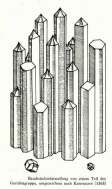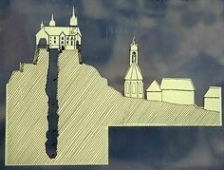Historical
BASALT - The stumbling block
The word " Stolpen " comes from the Old Slavic and means " pillar " , which, given the many basalt columns is here understood . Already the name of the first known owner of the castle Stolpen Moyko de Cuffs ( 1218 ) refers to this column.

The basalt of Stolpen has been almost 500 years always an important research project. When his first mention the literary source Carolus applies v. Miltitz ( 1520). For the famous Saxon naturalist Agrigola ( 1546 ) was of a very special Stolpener basalt rock , so Stolpen today is considered the type locality for all basalt. Kent Man ( 1565) recorded the first three-dimensional Basalt Group - the tips on the basalts were probably the hardness of the rock symbolize.
Melting experiments and chemical analyzes on the basalt of Stolpen are already known from the 18th century ( Pott 1751, Meyer 1780 Schultze 1759 and 1769). It was also about the use of the melt for the production of optical glasses , which were unsuccessful , however.
There are also indications from the 18th century that melted basalt of Stolpen said to have been used as a glaze for Böttger porcelain , but this unfortunately there is no evidence. Also J.v.Goethe has appraised the Basalt in Stolpen on 31 July 1790th As an advocate of Neptunists theory he was convinced that this rock was formed by deposition / sedimentation in the water. The Plutonists to Hamilton ( 1779) but ultimately retained in this major scientific controversy right - without Magma arises no basalt.
One of the first geological maps in Saxony with a typology of basalt , here the sheet Stolpen , come from Geinitz (1882 ) and Klemm ( 1890). More extensive research on basalt of Stolpen found , for example, held by Koch ( 1983) , which also investigated the magnetism of basalt and caused a complete mapping of the basalt columns. It also extensive mineralogical and chemical analyzes were realized.

Particularly interesting is the deep wells on the castle as a masterpiece of late medieval architecture. With 84.4 m it is the deepest wells, the groundwater also be construed from the basalt. For well construction 1607 - 1630 are numerous exciting information and data. For the drilling of the well four experienced miners were brought out of the Osterzgebirge (Berggießhübel) lifetime to Stolpen. Some special mining methods such as the fire and set Lutten were used for these wells.For many years I care mostly volunteer around the basalt of Stolpen, I can see the old quarry from my office.
Geological permanent exhibition at the Castle, the action Heritage Day with the unique basalt vaulted cellars in the city, excursions to the day of Geotops, further exhibition projects for Basalt, for example in Kamenz, guided tours and excursions on the topic Basalt in Saxony and Bohemia, marketing Basalt for interested Geotouristen, lectures on the BASALT2013 are there just a few examples. Since 2006 the Stolpener Castle Hill is a National Geotope.


